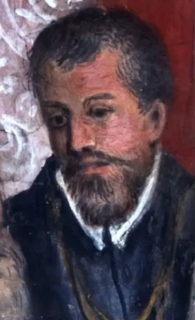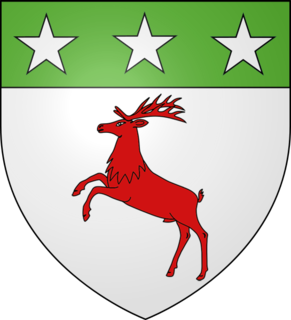Related Research Articles
Sorley Boy MacDonnell, also spelt as MacDonald, Scoto-Irish chief, was the son of Alexander MacDonnell, lord of Islay and Kintyre (Cantire), and Catherine, daughter of the Lord of Ardnamurchan, both in Scotland. MacDonnell is best known for establishing the MacDonnell clan in Antrim, Ireland, and resisting the campaign of Shane O'Neill and the English crown to expel the clan from Ireland. Sorley Boy's connection to other Irish Catholic lords was complicated, but also culturally and familiarly strong: for example, he married Mary O'Neill the daughter of Conn O'Neill. He is also known in English as Somerled and Somerled of the yellow hair.

The Cathach of St. Columba, known as The Cathach, is a late 6th century Insular psalter. It is the oldest surviving manuscript in Ireland, and the second oldest Latin psalter in the world.

Rory O'Donnell, younger brother of Hugh Roe O'Donnell, was the last King of Tyrconnell and 1st Earl of Tyrconnell.

Newport, historically known as Ballyveaghan and for many years also known as Newport-Pratt, is a small town in the barony of Burrishoole, County Mayo, Ireland. The population was 626 in 2016. It is located on the west coast of Ireland, along the shore of Clew Bay, north of Westport. The N59 road passes through the town. The county town of Castlebar is approx 18 km east of Newport. The Black Oak River flows through the centre of the town and there are walking paths along its banks.
Hugh Roe O'Donnell, also known as Red Hugh O'Donnell, was a sixteenth-century Irish nobleman. He became Chief of the Name of Clan O'Donnell and Lord of Tyrconnell in 1593 after a succession dispute within the O'Donnell dynasty, and after escaping a five-year imprisonment in Dublin Castle by the English. Along with his father-in-law Hugh O'Neill of Tyrone, he led an alliance of Irish clans in the Nine Years' War against the English government in Ireland. Hugh Roe led an Irish army to victory in the Battle of Curlew Pass. After defeat in the Siege of Kinsale, he travelled to Spain to seek support from King Philip III. Unsuccessful, he died in Spain and was succeeded by his younger brother Rory O'Donnell. He is sometimes also known as Aodh Ruadh II or Red Hugh II, especially in his native County Donegal.

The O'Donnell dynasty were the dominant Irish clan of the kingdom of Tyrconnell, Ulster, in medieval and early-modern Ireland.

The O’Doherty family is an Irish clan based in County Donegal in the north of the island of Ireland.

Tyrconnell, also spelled Tirconnell, was a kingdom of Gaelic Ireland, associated geographically with present-day County Donegal, which has sometimes been called County Tyrconnell. At times it also included parts of County Fermanagh, County Sligo, County Leitrim, County Tyrone and County Londonderry at its greatest extent. The kingdom represented the core homeland of the Cenél Conaill people of the Northern Uí Néill and although they ruled, there were smaller groups of other Gaels in the area.

Hugh Albert O'Donnell, 2nd Earl of Tyrconnell, was titular King of Tír Conaill, and son of Rory O'Donnell, 1st Earl of Tyrconnell whose title was however attainted in 1614. In adult life, he used the style Earl of Tyrconnell, Baron of Donegal and Lifford, Lord of Sligo and Lower Connaught, and Knight Commander of the Order of Alacantara.
During the Tudor conquest of Ireland (c.1540–1603), "surrender and regrant" was the legal mechanism by which Irish clans were to be converted from a power structure rooted in clan and kin loyalties, to a late-feudal system under the English legal system. The policy was an attempt to incorporate the clan chiefs into the English-controlled Kingdom of Ireland, and to guarantee their property under English common law, as distinct from the traditional Irish Brehon law system. This strategy was the primary non-violent method for Crown officials in the Dublin Castle administration to subjugate Irish clan leaders during the conquest.

The O'Neill dynasty is a lineage of Irish Gaelic origin, that held prominent positions and titles in Ireland and elsewhere. As Kings of Cenél nEógain, they were historically the most prominent family of the Northern Uí Néill, along with the O'Donnell dynasty. The O'Neills hold that their ancestors were kings of Ailech during the Early Middle Ages, as descendants of Niall of the Nine Hostages.
Murrough na dTuadh Ó Flaithbheartaigh, anglicised Sir Murrough O'Flaherty was Chief of Iar Connacht,.

Porthall is a village and townland in County Donegal, Ireland. The village is located on the west bank of the River Foyle, in The Laggan district of East Donegal, on the R265 road. The nearest town is Lifford, the county town.
The O'Donnell Baronetcy, of Newport House in the County of Mayo, was a title in the Baronetage of Ireland. It was created on 22 December 1780 for Neale O'Donnell. Initially a Catholic, he renounced this faith and became a Protestant before being created a baronet. Hugh O'Donnell, eldest son of the first Baronet, sat as a member of the Irish House of Commons for Donegal Borough, and James Moore O'Donnell, second son of the first Baronet, was member for Ratoath. Both were opposed to the Act of Union and predeceased their father. The latter was succeeded by his third son, Neale, the second Baronet. The title became dormant on the death of the fifth Baronet in 1889.
Burrishoole is one of the nine baronies of County Mayo in Ireland. It is named after the former Gaelic territory of Umhaill, which also included Murrisk barony, and roughly means the "borough of Umhaill".

Umhaill or Umhall was a Gaelic territory around Clew Bay in the west of what is now County Mayo, Ireland, comprising the baronies of Burrishoole and Murrisk. By the 12th century, its ruling dynasty were known as the Uí Máille (O'Malleys). Originally an autonomous part of the kingdom of Connacht, it later became one of the vassal territories of the Mac William Íochtar. Umhaill's last and most famous ruler was Grace O'Malley, nicknamed "the pirate queen". In 1576, during the Tudor conquest of Ireland, she agreed to the surrender and regrant policy, accepting English inheritance law in return for official title deeds to her lands. On her death the lands were inherited by her son Tibbot "na Long". Umhaill had a strong seafaring culture. Important sites associated with it include Carrickkildavnet Castle, Carrickahowley Castle, Granuaile's Castle and Clare Island Abbey.
Donnell Irrais Ó Conchobair, Gaelic-Irish lord, fl. 1272–74.
Sir Donal O'Donnell was a member of the O'Donnell dynasty of Tyrconnell in modern-day County Donegal. He was the eldest son of Sir Hugh McManus O'Donnell, the Lord of Tyrconnell for much of the reign of Elizabeth I.
The Battle of Lifford was fought in County Donegal in October 1600, during the Nine Years' War in Ireland. A mixed Anglo-Irish force under Sir John Bolle and the Gaelic leaders Niall Garve O'Donnell and Sir Arthur O'Neill captured the strategic town of Lifford. A subsequent attempt to recapture it by forces led by Red Hugh O'Donnell failed.
Daniel O'Donnell (1666–1735) was a brigadier-general in the Irish Brigade in the French service. He belonged to the family of O'Donnell, chiefs in Tyrconnel.
References
- ↑ Guy Beiner, "In Pursuit of a People’s Hero: Remembering Father Manus Sweeney and The Year of the French" in Mayo, History and Society: Interdisciplinary Essays on the History of an Irish County, edited by Gerard Moran and Nollaig Ó Muraíle (Dublin: Geography Publications, 2014), pp. 301-18.
- Annala Beaga Pharaiste Bhuireis Umhaill. A short account of the history of Burrishoole parish, P. O Morain, Burrishoole, 1957.
- The Return of the Cathach to Ireland, Michael Herity, in Seanchas:Studies in Early and Medieval Irish Archaeology, History and Literature in Honour of Francis John Byrne , Dublin, 2000; p. 455, 456, 461, (pp. 454–64).